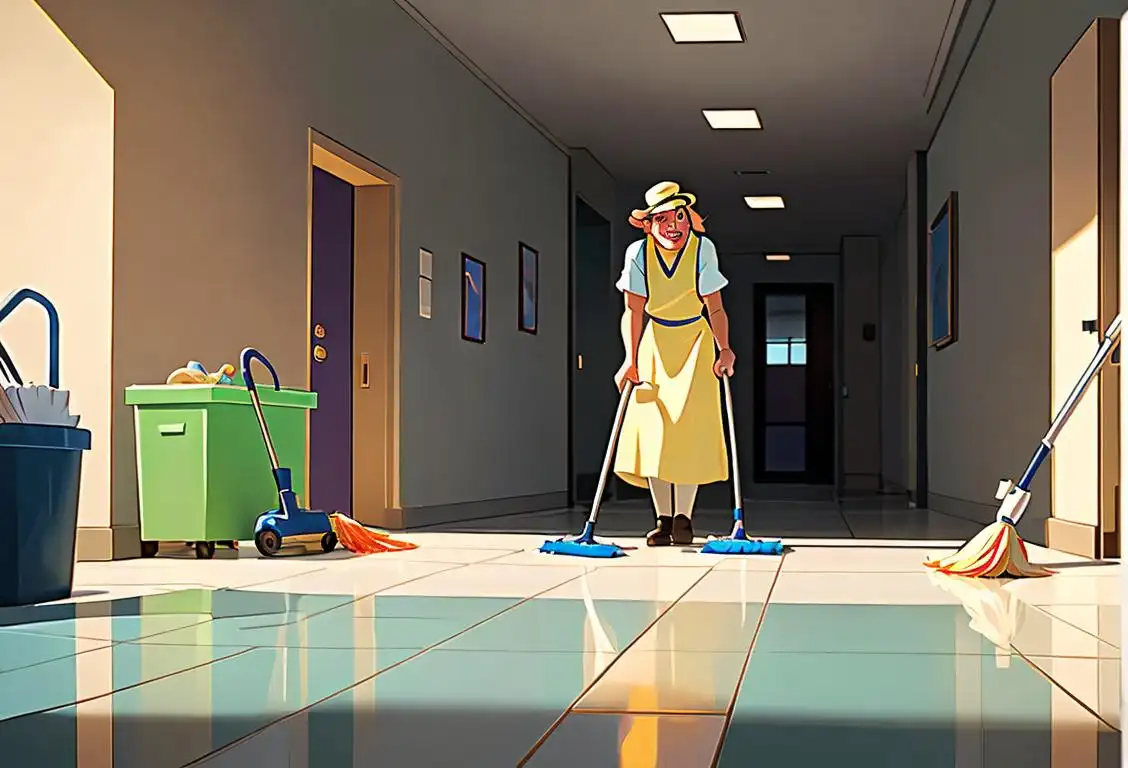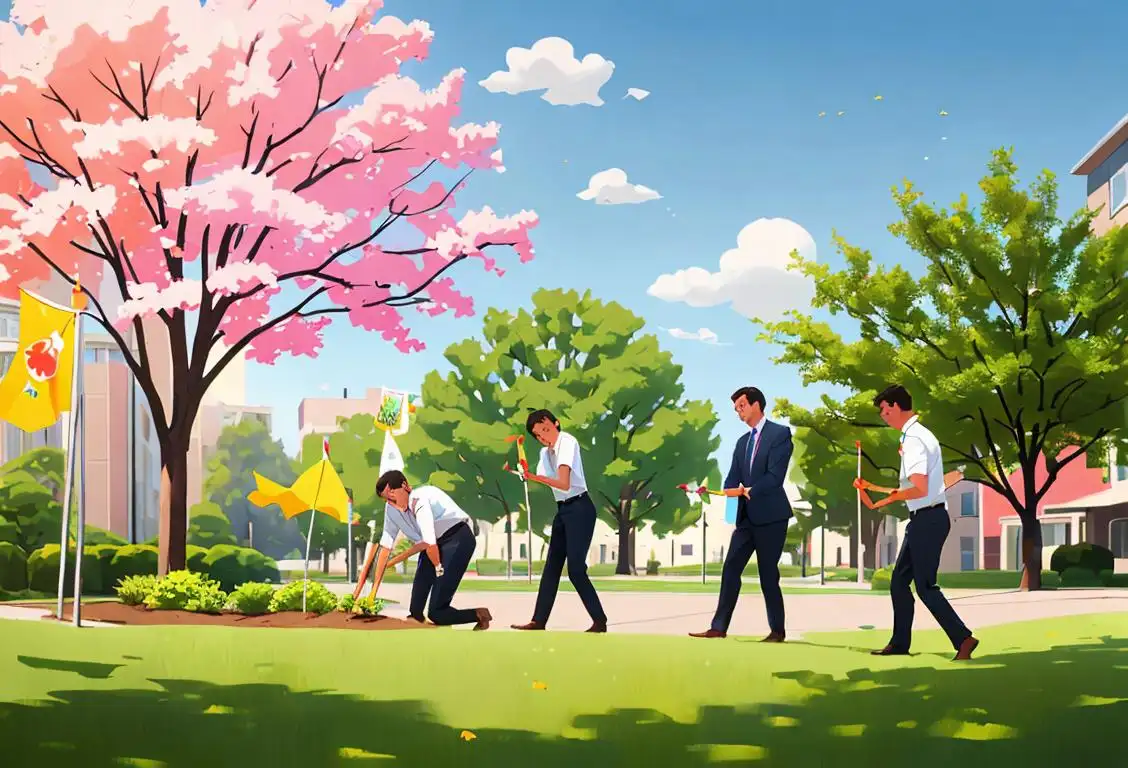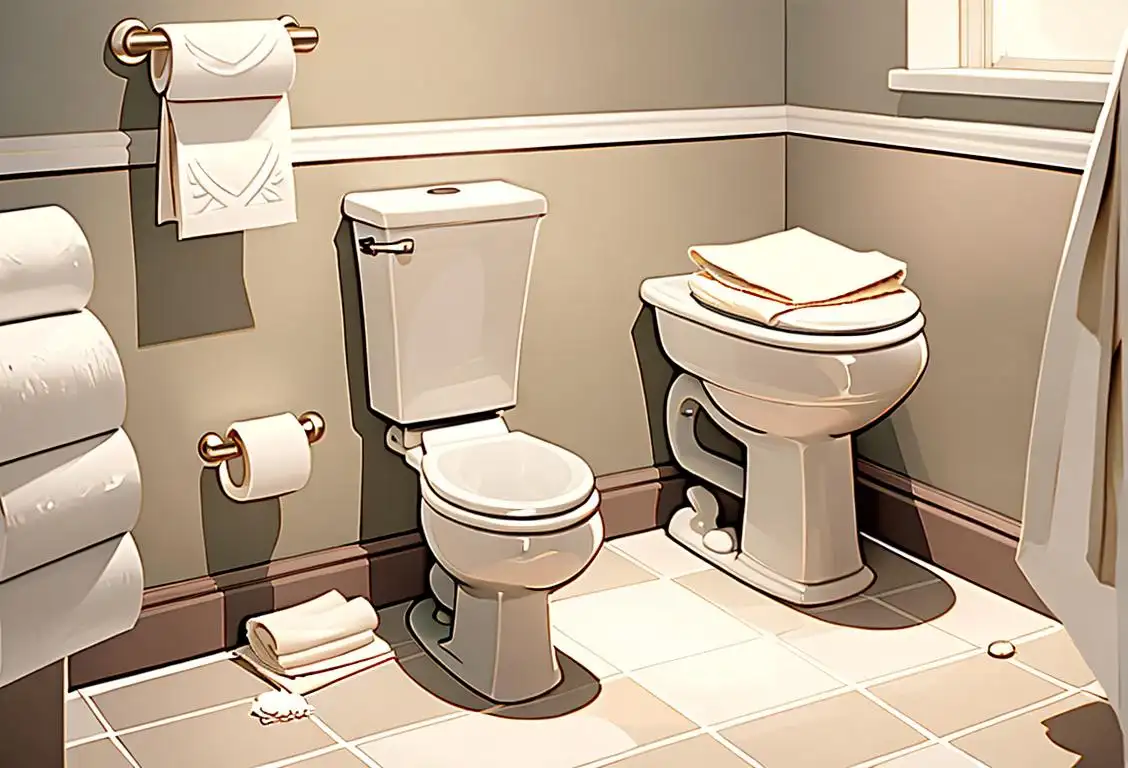National Custodial Recognition Day

Welcome to the wacky and wonderful world of National Custodial Recognition Day! Get ready to celebrate the unsung heroes who keep our spaces clean and tidy. This remarkable day is all about showing appreciation for those devoted janitors and custodians who make our lives a little more spick and span. So grab your broom and let's dive into the fascinating history of this cleanliness-filled celebration!
When is Custodial Recognition Day?
It's national custodial recognition day on the 2nd October.
The Origins of National Custodial Recognition Day
There's no denying the hard work and dedication of custodial staff around the world. And in the age of the internet, it was only a matter of time before someone decided to give them the recognition they deserve with a national day. While the exact origins of National Custodial Recognition Day are shrouded in mystery, it's safe to say that it emerged as a grassroots movement to honor these unsung heroes. Whether it was an elaborate prank by mischievous office workers or a genuine effort to show appreciation, we may never know. But one thing's for sure – it's a day to celebrate the people who keep our spaces clean and germ-free!
How to Celebrate National Custodial Recognition Day
If you're wondering how to properly honor those who clean up after us, we've got you covered! Here are a few ideas to get you started:
- Leave a thank-you note for the custodial staff at your workplace or school. Let them know their hard work is appreciated!
- Organize a surprise celebration or potluck to show your gratitude. Whip up some delicious treats and invite the custodial staff to enjoy the festivities.
- Offer to help out with cleaning tasks for a day. Give those hardworking custodians a break and take on some of their responsibilities.
- Spread the word on social media using the hashtag #CustodialRecognitionDay. Share stories of exceptional janitors or custodians who have made a positive impact on your life.
Fun Fact about Custodial Recognition Day
Did you know that some custodial staff have found surprisingly valuable items while cleaning? From forgotten wallets filled with cash to lost diamond rings, you never know what treasures they might stumble upon. So next time you see a custodian, give them a thumbs up – they might just have a story to tell!
History behind the term 'Custodial Recognition'
1975
Introduction of the concept
Custodial recognition emerged as a term in 1975 when it was first introduced in the field of cultural heritage and museum studies. It referred to the acknowledgement and appreciation of the crucial role custodians play in preserving and safeguarding cultural artifacts.
1954
Introduction of the term 'custodial recognition'
In 1954, the term 'custodial recognition' was first introduced. It refers to the act of giving acknowledgement or validation to the efforts and contributions made by custodial workers. These workers are often responsible for the cleanliness, maintenance, and security of various spaces, yet their work is often underappreciated or goes unnoticed. The term 'custodial recognition' aims to highlight the importance of recognizing and honoring these essential workers.
1950
The Birth of Custodial Recognition
In the year 1950, the term 'custodial recognition' was first coined. It emerged in the field of psychology as a concept to describe the acknowledgement and validation of an individual's emotional and psychological needs in a caregiving setting, often related to the care and custody of children.
1974
Emergence of the term
The term 'custodial recognition' first emerged in 1974 within the field of art history. It refers to the responsibility of institutions, such as galleries and museums, to officially acknowledge and care for the artworks in their possession. This recognition entails not only the physical preservation of the artwork, but also the intellectual and cultural acknowledgment of its importance.
1956
Emergence of the term
The term 'custodial recognition' emerged in 1956 as a concept in the field of art conservation. It refers to the acknowledgement and documentation of the individuals responsible for the care, preservation, and maintenance of artworks. This recognition became crucial in ensuring proper custodial practices and safeguarding the artistic heritage.
1950
Birth of the term
The term 'custodial recognition' was first coined in 1950 in the field of psychology. It referred to the acknowledgement and validation of a person's emotional and psychological needs within a custodial or caregiving relationship. It emphasized the importance of recognizing and meeting the needs of individuals who were under the care of others.
1965
Birth of the term
The term 'custodial recognition' was first coined in 1965. It was a concept that emerged in relation to the burgeoning field of art restoration and conservation. Custodial recognition referred to the act of acknowledging and appreciating the custodians or caretakers of artworks who worked tirelessly behind the scenes to ensure the preservation and longevity of cultural treasures.
1935
Introduction of the term 'custodial recognition'
The term 'custodial recognition' was first coined in 1935. It was used to describe the act of giving acknowledgement or validation to the custodial duties and responsibilities performed by individuals or organizations. At the time, it primarily referred to the recognition and appreciation of the work done by custodial staff who maintained the cleanliness and orderliness of buildings and facilities.
1923
The Birth of Custodial Recognition
In 1923, the term 'custodial recognition' was first coined to describe the acknowledgement and validation of the custodial responsibilities that individuals have in the care and protection of others. This term was primarily used in the context of child custody cases, highlighting the importance of recognizing and appreciating the efforts of custodial parents or guardians.
1965
Development of Custodial Recognition Theory
By 1965, custodial recognition had gained recognition as a key aspect of providing quality care for individuals in various institutional settings. Psychologists and researchers began developing theories that explored the importance of acknowledging and meeting the emotional needs of those under custodial care.
1972
Increased focus on art preservation
During the early 1970s, there was a growing recognition of the importance of preserving and protecting artworks from deterioration and damage. This led to a greater emphasis on the role of custodians and their expertise in maintaining the aesthetic and historical value of precious artifacts. The term 'custodial recognition' gained traction within the art community, signifying the acknowledgment of these diligent caretakers.
1983
Protecting cultural heritage
In 1983, UNESCO adopted the Charter for the Conservation of Cultural Heritage, which emphasized the importance of custodial recognition in safeguarding cultural artifacts. The charter recognized the responsibility of institutions to preserve and document cultural heritage for future generations. This global acknowledgement further solidified the significance of custodial recognition in the art world.
1960s
Expansion of the concept
In the 1960s, as the focus on workplace equality and fairness grew, the concept of 'custodial recognition' expanded beyond just custodial staff. It began to encompass recognizing and appreciating the often overlooked and undervalued work performed by various support staff, such as janitors, maintenance personnel, security officers, and other similar roles. The term became a way to highlight and honor the contributions of these essential workers.
1983
Shift from preservation to interpretation
During the early 1980s, there was a shift in the understanding of custodial recognition. It was not merely confined to the act of preservation, but also extended to encompass interpretation. Custodians were recognized for their ability to provide insights, contextualize artifacts, and engage audiences in meaningful ways.
1972
Institutional recognition
In 1972, 'custodial recognition' gained broader acknowledgment within the art community. Institutions, such as museums and galleries, started to place greater emphasis on crediting the custodians of artworks alongside the artists themselves. This recognition highlighted the collaborative efforts of both artists and custodial staff in preserving cultural treasures.
1960
Expansion to educational settings
In the 1960s, the concept of custodial recognition expanded beyond the realm of psychology and gained traction in educational settings. It highlighted the significance of recognizing and supporting the emotional well-being and individuality of students within a school environment. This recognition aimed to create nurturing and inclusive learning environments where students' emotional needs were acknowledged alongside their academic development.
1939
Custodial Recognition in Education
In 1939, 'custodial recognition' gained significance in the field of education. It referred to the acknowledgment of the role of teachers and schools in providing not just academic instruction but also nurturing and guidance to students. This recognition emphasized the idea that educators are entrusted with the responsibility of shaping young minds and fostering holistic development.
1970
Rise of the labor movement and custodial recognition
In the 1970s, there was a rise in the labor movement, which played a significant role in advocating for the rights and fair treatment of workers. During this time, custodial workers started to gain more recognition and support from labor unions. The term 'custodial recognition' gained prominence as a means to acknowledge their contributions and advocate for better working conditions and benefits.
1995
Recognition of custodians' cultural expertise
In 1995, custodial recognition took a significant leap forward by acknowledging the cultural expertise of custodians. It highlighted the fact that custodians of cultural heritage possess unique knowledge and skills that contribute to the preservation, understanding, and transmission of cultural traditions and practices.
1998
Public awareness and appreciation
By 1998, 'custodial recognition' had moved beyond just institutional practice. The term increasingly found its way into public discourse, generating awareness and fostering appreciation for the indispensability of custodial work in art conservation. It shed light on the usually hidden work done behind the scenes to safeguard and maintain artistic masterpieces.
1984
Custodial recognition as a workplace initiative
By the mid-1980s, 'custodial recognition' had evolved into a workplace initiative aimed at improving employee morale and job satisfaction. Many companies and organizations implemented programs to publicly appreciate and recognize the custodial staff for their hard work and dedication. These initiatives included award ceremonies, appreciation events, and other forms of acknowledgment, highlighting the value of custodial workers.
1967
Expansion to Healthcare
By 1967, the concept of 'custodial recognition' expanded to include the healthcare sector. It highlighted the recognition and appreciation for healthcare professionals who provide compassionate and dedicated care to patients. This term aimed to emphasize the vocation-like aspect of healthcare professions and to acknowledge their tireless efforts in promoting the health and well-being of individuals.
1990s
Recognition of care work
During the 1990s, a significant shift occurred in the understanding of 'custodial recognition.' It started to include recognition of care work, such as the caregiving roles in healthcare, elderly care, and child care. The term emphasized the importance of acknowledging the efforts and dedication of those providing custodial care and support to vulnerable individuals in various settings.
1987
Inclusion in museum discourse
As the field of art conservation continued to develop, the term 'custodial recognition' became more prevalent in museum discourse. Museums began recognizing the integral role of custodianship in preserving cultural heritage and started actively acknowledging the efforts of those involved in the long-term care of artworks. This acknowledgment helped raise public awareness about the significance of custodial work and its impact on maintaining the integrity of art collections.
1992
Access and interpretation
By 1992, the concept of custodial recognition expanded beyond mere preservation to encompass access and interpretation. Institutions recognized the need to not only protect artworks but also make them accessible to the public and provide meaningful interpretation. This shift allowed for greater engagement and understanding of cultural treasures.
1975
Legal implications
By the mid-1970s, custodial recognition started to have legal implications. In this context, it referred to the recognition of the custodial rights of parents or legal guardians. It emphasized the importance of acknowledging and protecting the rights and responsibilities of individuals or entities who have been granted the custodial care of a child, ensuring the child's best interests are upheld.
1978
Expansion of Custodial Recognition in Education
In 1978, the concept of custodial recognition expanded beyond caregiving institutions and found its way into the field of education. Recognizing the importance of acknowledging and validating students' emotional needs, educators started incorporating custodial recognition practices into their classrooms, creating more nurturing and inclusive learning environments.
1997
Recognizing custodial workers on a national scale
In 1997, national custodial recognition efforts gained traction. This involved designating specific days or weeks to honor custodial workers across the country. These national observances aimed to raise awareness about the essential role custodial workers play in maintaining clean and safe environments. It also provided an opportunity for the general public to express gratitude and appreciation for their often unacknowledged contributions.
2015
Expansion to other fields
'Custodial recognition' began to expand beyond the realm of art conservation in 2015. The concept was adopted across various domains that involved the care, preservation, and maintenance of cultural artifacts. This included fields like archaeology, library sciences, archives, and even digital preservation, emphasizing the importance of recognizing custodial expertise across different disciplines.
2010s
Broader social recognition
In the 2010s, 'custodial recognition' gained broader social recognition as a term encompassing the appreciation of any unrecognized, often undervalued, and vital contributions to society. It became a way to express gratitude to individuals or groups whose efforts might go unnoticed, ranging from those who work behind the scenes to preserve cultural heritage, volunteers who help with disaster relief, activists advocating for marginalized communities, and many other forms of unrecognized caregivers, workers, and activists.
2007
Empowering custodians through partnership
In 2007, custodial recognition evolved to emphasize the need for partnership and collaboration between custodians, researchers, and communities. It recognized the importance of empowering custodians and involving them directly in decision-making processes related to the management, interpretation, and presentation of cultural heritage.
1990
Organizational management
In the 1990s, the term 'custodial recognition' expanded further into the realm of organizational management. It began to signify the acknowledgment and appreciation of employees' contributions and needs by their employers. This recognition aimed to create a positive and supportive work culture, fostering employee engagement and loyalty.
1993
Custodial Recognition in Legal Context
In 1993, 'custodial recognition' found its place in the legal realm. It referred to the acknowledgement of the responsibilities and authority given to custodians or legal guardians, particularly in cases involving the care and protection of dependents. This recognition underscored the importance of ensuring the best interests of those who rely on custodians for their welfare and safety.
2005
Controversies and restitution
In 2005, controversies surrounding custodial recognition and restitution intensified. The discussion focused on the repatriation of artworks, especially those obtained during colonial times. Institutions faced increased pressure to address the historical context of artworks on display and to consider returning them to their countries of origin. This debate brought custodial recognition to the forefront of discussions on cultural heritage and ownership.
2005
Global recognition and appreciation
By the early 2000s, the notion of custodial recognition had permeated the global art community. Institutions and organizations worldwide started incorporating the concept into their policies and practices. The term not only referred to the preservation of physical artworks but also encompassed the broader recognition of custodians as vital contributors to cultural heritage. This recognition highlighted the skilled craftsmanship, knowledge, and dedication required for safeguarding artworks for future generations.
1993
Influence on Legal Systems
As custodial recognition gained prominence, its influence spread to legal systems around the world. In 1993, family law began recognizing the significance of custodial recognition in divorce and custody cases. Courts started considering the emotional needs and well-being of children when making decisions about custody arrangements, emphasizing the importance of maintaining a strong custodial bond.
2005
Societal Embrace of Custodial Recognition
In 2005, 'custodial recognition' gained widespread acceptance as a term used to celebrate the care, support, and efforts provided by various custodial figures in society. It became significant in honoring parents, guardians, educators, healthcare professionals, and others who dedicate themselves to the well-being and development of those under their care. This term highlights the recognition of their often unsung and invaluable contributions.
2010
Custodial Recognition in Workplace
By 2010, custodial recognition had also made its way into the realm of workplace dynamics. Companies and organizations began implementing practices that emphasized acknowledging and valuing the emotional welfare of their employees. This recognition of individuals' emotional needs contributed to improved job satisfaction, higher productivity, and enhanced overall well-being in the workplace.
Present
Continued importance and appreciation
In the present day, custodial recognition remains an essential aspect of art conservation and museum practices. It serves as a reminder of the collaborative efforts involved in preserving cultural artifacts, ensuring their accessibility, and safeguarding their significance for future generations. The term not only honors custodians but also fosters a deeper appreciation for the behind-the-scenes work that contributes to the longevity and cultural value of artworks.
2005
Cultural impact
In the 21st century, custodial recognition has gained significance in various aspects of society, including healthcare, customer service, and more. It has become a fundamental principle in the provision of quality care, ensuring that individuals' emotional well-being and dignity are recognized and respected. With an increased focus on person-centered approaches, custodial recognition continues to shape and improve various areas of our lives.
2015
International recognition
By 2015, custodial recognition had gained international recognition as a crucial aspect of cultural heritage management. It became an integral part of international agreements and charters aiming to protect and promote cultural diversity and heritage. This global recognition further solidified the importance of custodians in preserving and perpetuating cultural knowledge.
Present
Continued prominence
Today, 'custodial recognition' continues to evolve as a significant aspect of cultural heritage preservation. It serves as a reminder of the collaborative efforts between creators, custodians, and caretakers of our shared cultural legacy. By recognizing and honoring the custodians, we honor the essential work that safeguards and ensures the longevity of our cultural heritage.
2020
Digital custodial recognition
In the digital age, custodial recognition has extended beyond physical artworks. Online platforms and museums now face the challenge of preserving and acknowledging digital cultural artifacts. The concept of custodial recognition continues to evolve to include ethical considerations regarding the digital representation and accessibility of cultural heritage in a rapidly changing technological landscape.
Present
Continued significance and impact
Today, custodial recognition remains an important aspect of workplace culture and societal appreciation. Many organizations continue to prioritize recognizing custodial workers, understanding the vital role they play in maintaining hygiene and cleanliness. National custodial recognition days are widely celebrated, offering a platform for individuals, communities, and companies to show support and gratitude toward custodial workers.
Did you know?
Did you know that some custodial staff have found surprisingly valuable items while cleaning? From forgotten wallets filled with cash to lost diamond rings, you never know what treasures they might stumble upon. So next time you see a custodian, give them a thumbs up – they might just have a story to tell!Tagged
fun appreciation workplace cleanlinessFirst identified
2nd October 2015Most mentioned on
2nd October 2020Total mentions
31Other days
Custodial Recognition Day
Clean Your Desk Day
Csr Day
Admin Professionals Day
Toilet Paper Day
Managers Day
Whistleblower Appreciation Day
Clean Off Your Desk Day
School Librarian Day
Teacher Day








